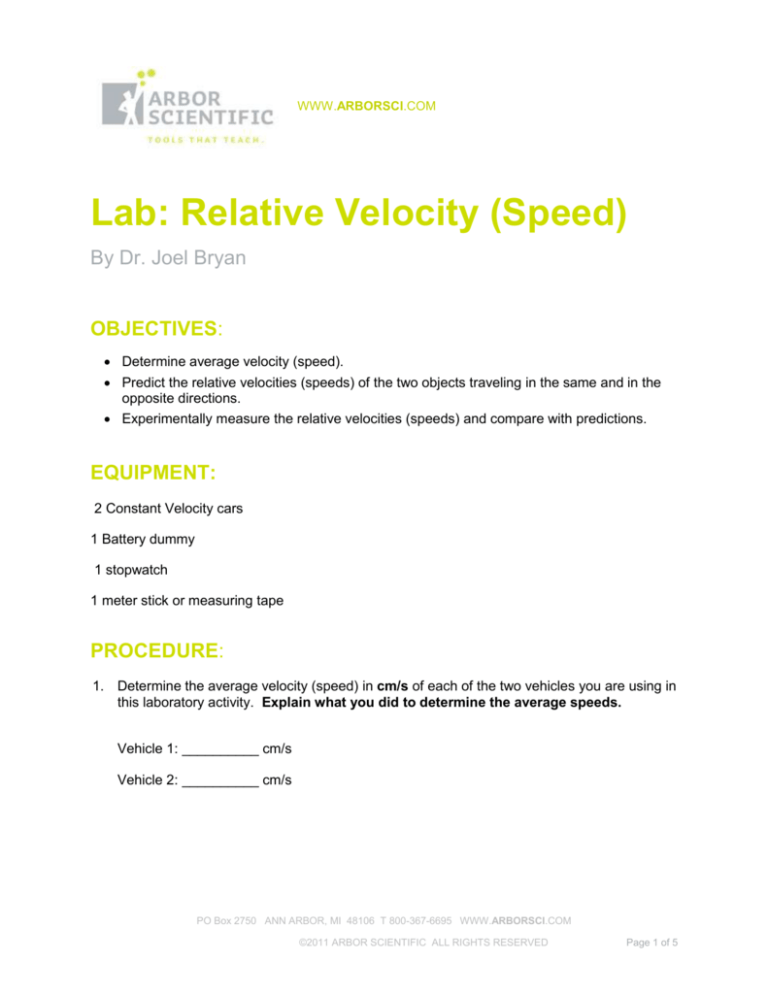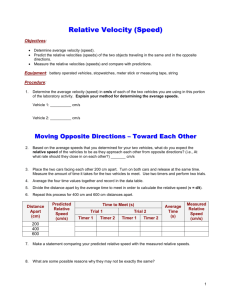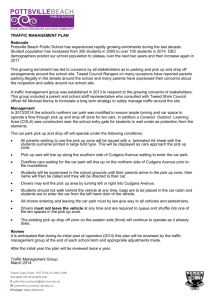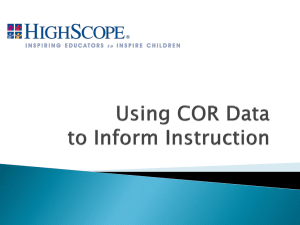
WWW.ARBORSCI.COM
Lab: Relative Velocity (Speed)
By Dr. Joel Bryan
OBJECTIVES:
Determine average velocity (speed).
Predict the relative velocities (speeds) of the two objects traveling in the same and in the
opposite directions.
Experimentally measure the relative velocities (speeds) and compare with predictions.
EQUIPMENT:
2 Constant Velocity cars
1 Battery dummy
1 stopwatch
1 meter stick or measuring tape
PROCEDURE:
1. Determine the average velocity (speed) in cm/s of each of the two vehicles you are using in
this laboratory activity. Explain what you did to determine the average speeds.
Vehicle 1: __________ cm/s
Vehicle 2: __________ cm/s
PO Box 2750 ANN ARBOR, MI 48106 T 800-367-6695 WWW.ARBORSCI.COM
©2011 ARBOR SCIENTIFIC ALL RIGHTS RESERVED
Page 1 of 5
Moving Opposite Directions – Toward Each Other
If you know the average speeds of two different vehicles, then you can determine what their relative
speed will be as they move toward each other from some specified distance away.
2. Based on the average speeds that you determined for your two vehicles, what do you predict the
relative speed of the vehicles to be as they approach each other from opposite directions? (i.e.,
At what rate should they close in on each other?) _______ cm/s. Record this value in the data
table.
3. Place the two cars facing each other 300 cm apart. Turn on both cars and release at the same
time. Measure the amount of time it takes for the two vehicles to meet. Use two timers and
perform two trials.
4. Average the four time values together and record in the data table.
5. Divide the distance apart by the average time to meet in order to calculate the relative speed (v
= d/t).
6. Repeat this process for closing distances of 600 cm and 900 cm.
Distance
Apart
(cm)
Predicted
Relative
Speed
(cm/s)
Time to Meet (s)
Trial 1
Timer 1
Trial 2
Timer 2
Timer 1
Average
Timer 2
Time
(s)
Measured
Relative
Speed
(cm/s)
300
600
900
7. Make a statement comparing your predicted relative speed with the measured relative speeds.
8. What are some possible reasons why they may not be exactly the same?
PO Box 2750 ANN ARBOR, MI 48106 T 800-367-6695 WWW.ARBORSCI.COM
©2011 ARBOR SCIENTIFIC ALL RIGHTS RESERVED
Page 2 of 5
Moving Same Direction – Faster Car in Back:
It is also possible to investigate relative speed when the cars are traveling in the same direction with
the faster car catching up to the slower car, as shown below.
9. Based on the average speeds that you determined for your two vehicles, what do you expect the
relative speed to be as the faster vehicle catches up to the slower one from behind? (i.e., At
what rate does the faster vehicle close in on the other vehicle?) _______ cm/s. Record this
value in the data table.
10. Place the two cars facing the same direction with the front end of the faster rear car 100 cm
behind the back end of the slower front car. Turn on both cars and release at the same time.
Measure the amount of time it takes for the faster rear car to catch up to the slower front car.
Use two timers and perform two trials.
11. Average the four time values together and record in the data table.
12. Divide the distance apart by the average time to meet in order to calculate the relative speed (v
= d/t).
13. Repeat this process for closing distances of 200 cm and 300 cm.
Distance
Apart
(cm)
Predicted
Relative
Speed
(cm/s)
Time to Meet (s)
Trial 1
Timer 1
Timer 2
Trial 2
Timer 1
Average
Timer 2
Time
(s)
Measured
Relative
Speed
(cm/s)
100
200
300
14. Make a statement comparing your predicted relative speed with the measured relative speeds.
15. What are some possible reasons why they may not be exactly the same?
PO Box 2750 ANN ARBOR, MI 48106 T 800-367-6695 WWW.ARBORSCI.COM
©2011 ARBOR SCIENTIFIC ALL RIGHTS RESERVED
Page 3 of 5
Moving Opposite Directions – Away From Each Other:
It is also possible to investigate relative speed when the cars are traveling in opposite directions
away from each other, as shown below. One way to do this is to start the cars some specified
distance apart, release them at the same time, and then visually locate the positions of the cars at
some specified time after release. The change in the distance apart divided by the time will be their
relative speed.
16. Based on the average speeds that you determined for your two vehicles, what do you
expect the relative speed of the vehicles to be as they move away from each other? (i.e.,
At what rate should the distance between them increase?) _______ cm/s. Record this
value in the data table.
17. Begin each run with the fronts of the cars some specified distance apart. Use tape to mark
the starting positions. Record this initial distance apart in the data table.
18. Release the cars at the same time and have spotters note the positions of the fronts of the
cars 2 seconds after release. Measure their new distance apart and record in the data
table. Perform another trial and record in the data table. Average the two distances and
record in the table.
19. Subtract the initial distance apart from the final distance apart to obtain the change in
distance apart. Divide the average change in distance apart by the time to determine their
relative speed.
20. Repeat this process for running times of 4 and 6 seconds.
Initial
Distance
Apart
(cm)
Predicted
Relative
Speed
(cm/s)
Running
Time
(s)
Final Distance
Apart (cm)
Trial 1
Trial 2
Measured
Average
Distance
Apart
(cm)
Change in
Distance
Apart
(cm)
Relative
Speed
(cm/s)
2
4
6
21. Make a statement comparing your predicted relative speed with the measured relative
speeds.
22. What are some possible reasons why they may not be exactly the same?
PO Box 2750 ANN ARBOR, MI 48106 T 800-367-6695 WWW.ARBORSCI.COM
©2011 ARBOR SCIENTIFIC ALL RIGHTS RESERVED
Page 4 of 5
Moving Same Direction – Faster Car in Front:
It is also possible to investigate relative speed when the cars are traveling in the same direction and
the faster car is in front pulls away from the slower rear car, as shown below. One way to do this is to
again start the cars some specified distance apart, release them at the same time, and then visually
locate the positions of the cars at some specified time after release. The change in the distance
apart divided by the time will be their relative speed.
23. Based on the average speeds that you determined for your two vehicles, what do you expect the
relative speed to be as the faster vehicle runs away from the slower one? (i.e., At what rate does
the faster vehicle leave the other vehicle behind?) _______ cm/s. Record this value in the data
table.
24. Begin each run with the fronts of the cars some specified distance apart. Use tape to mark the
starting positions. Record this initial distance apart in the data table.
25. Place the two cars facing the same direction at their starting positions. Release the cars at the
same time and have spotters note the positions of the fronts of the cars 2 seconds after
release. Measure their new distance apart and record in the data table. Perform another trial
and record in the data table. Average the two distances and record in the table.
26. Subtract the initial distance apart from the final distance apart to obtain the change in distance
apart. Divide the average change in distance apart by the time to determine their relative
speed.
27. Repeat this process for running times of 4 and 6 seconds.
Initial
Predicted
Distance Relative
Apart
Speed
(cm)
(cm/s)
Running
Time
(s)
Final Distance
Apart (cm)
Trial 1
Trial 2
Average
Distance
Apart
(cm)
Change
in
Distance
Apart
(cm)
Measured
Relative
Speed
(cm/s)
2
4
6
28. Make a statement comparing your predicted relative speed with the measured relative
speeds.
29. What are some possible reasons why they may not be exactly the same?
PO Box 2750 ANN ARBOR, MI 48106 T 800-367-6695 WWW.ARBORSCI.COM
©2011 ARBOR SCIENTIFIC ALL RIGHTS RESERVED
Page 5 of 5









